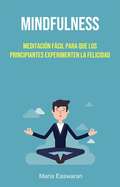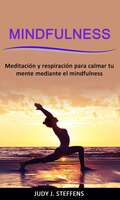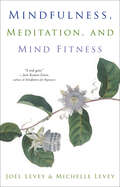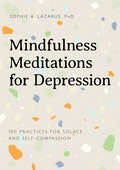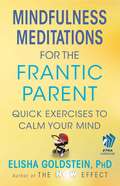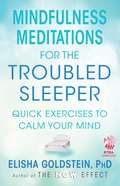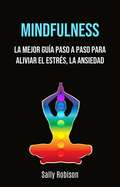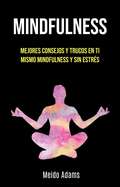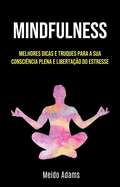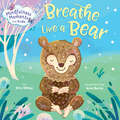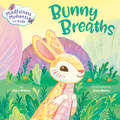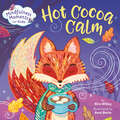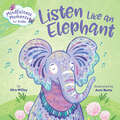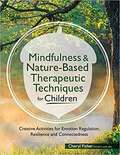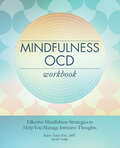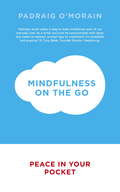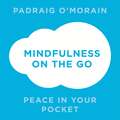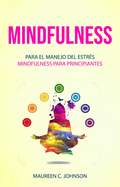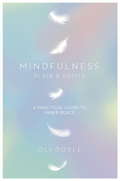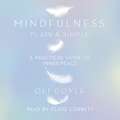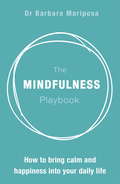- Table View
- List View
Mindfulness: Meditación Fácil Para Que Los Principiantes Experimenten La Felicidad
by Maria Easwaran¿Esta preocupado sobre cosas que no puede controlar? ¿Preocupado por esos objetivos y proyectos aún por completar? ¿Qué hay de sentir que no es la persona que quiere ser? Dirija su vida mediante las estrellas y haga brillar todas sus relaciones interpersonales. Este manual bellamente diseñado, guiado por el horóscopo, le enseñará a aportar energía a sus relaciones y a adivinar la verdadera naturaleza de las personalidades utilizando el poder de la astrología. Puede luchar contra la ansiedad y la depresión, o sentir que la dilación o el perfeccionismo lo están frenando. Independientemente del problema, ha comprado este libro con el deseo de cambiar sus pensamientos y sentimientos para mejor. Este clásico libro de autoayuda ofrece potentes herramientas de terapia cognitiva para que esto suceda. ¡Desplácese hacia arriba para comprar su copia hoy!
Mindfulness: Meditación y respiración para calmar tu mente mediante el mindfulness
by Judy J. SteffensYa sea que quieras calmar una mente sobreestresada con meditación, calmar el nervio vago para revolucionar tu salud, este paquete te ayuda a recuperar tu vida y seguir tus pasiones. ¿Estas buscando empezar una vida consciente? ¡Este libro es para tí! Este libro comienza con información básica sobre el Mindfulness. Esto es un poco de lo que descubrirás en el interior: -Descubriendo el camino de un Esencialista - Lo que significa practicar el Hygge -Pasos importantes para crear el estado mental de un Esencialista -Cómo integrar el Hygge a tu vida, trabajo, casa y relaciones -Por qué la meditación es algo que Ser y no algo que Hacer -Ejercicios meditativos simples pero altamente efectivos para tranquilizar tu mente -Cómo desarrollar mejores hábitos de sueño, dejar de sentirte estresado y disfrutar de un sueño más profundo -Formas sencillas de calibrar tu nervio vago y comprobar su estado de salud -Estrategias probadas para activar y curar tu nervio vago ¡Y mucho más! ¿Buscas comenzar una vida consciente? ¡Este libro es para ti! Comienza con información básica sobre el mindfulness. Después de eso, el libro pasa al mindful básico y más eficaz. Se proporcionan instrucciones detalladas para realizar cada ejercicio.
Mindfulness, Meditation, and Mind Fitness: (spiritual Fitness, Mindset, Focus, Stress-reduction)
by Michelle Levey Joel LeveyGet more out of meditation with this comprehensive guide to various techniques: &“A skillful blend of time-proven antidotes to the stress of modern life&” (Daniel Goleman, author of Emotional Intelligence). With this inspirational book, Joel and Michelle Levey offer a complete guide to inner exploration, whether you&’re new to meditation or an experienced practitioner. By breaking down mindfulness techniques into distinct categories, the Leveys offer readers an easy-to-use resource for getting more out of meditation. Seasoned experts on the topic of meditation, the Leveys were among the first to bring mind-fitness teachings into mainstream organizations. From NASA to Google, the Leveys have taught their techniques to people in leading corporations and government organizations, as well as at universities, medical centers, and more. This spiritual book is a treasury of the wisdom that they have amassed over the years. Through it, they share the mind-fitness disciplines necessary for personal mastery, wisdom, creativity, compassion, and resilience.
Mindfulness Meditations for Depression: 100 Practices for Solace and Self-Compassion
by Sophie A Lazarus PhDPractice self-compassion with 100 mindfulness meditations for depression The unhelpful patterns that fuel depression can become clearer, less intimidating, and easier to manage as we develop a mindfulness practice. Mindfulness Meditations for Depression is filled with gentle, step-by-step meditations to help bolster this awareness and break depression's hold on your life. Explore 100 accessible practices, structured around the seven principles of mindfulness: beginner's mind, non-judgment, acceptance, patience, trust, non-striving, and letting go. You'll learn how to use mindfulness techniques to better understand your mood, anxiety level, and overall well-being as you work through the challenges that life presents. While meditation is not a quick-fix for depression, the tools here can contribute to lasting relief. Mindfulness Meditations for Depression includes: Mindfulness for depression—Learn more about meditation and mindfulness, as well as the patterns of depression, including avoidance and rumination. Continuing self-care—Develop awareness around your emotions, thoughts, sensations, and behaviors so you can catch early warning signs of depression and employ mindful self-care tactics. Evidence-based methods—Discover meditations rooted in mindfulness-based cognitive therapy, which focuses on the development of mindfulness to cope with depressive patterns of thinking and prevent future relapse. Manage depression symptoms and find peace with Mindfulness Meditations for Depression.
Mindfulness Meditations for the Frantic Parent: The Now Effect
by Elisha GoldsteinYou have what it takes to be an excellent parent. You have all the answers within you; all you need to do is tap into that space and trust your instincts. Learn to listen to your intuition and break free from the tendencies that lead you to become a frantic, stressed-out parent. A leader in mindfulness psychology, Dr. Elisha Goldstein demonstrates how to use the space between stimulus and response to break free from habitual beliefs and thoughts that don’t serve you in becoming the best parent you can be. These techniques will allow you to connect to the present moment to make deep, permanent life changes. In essence, this book teaches the foundation for how the now—this very moment—can change the rest of your life
Mindfulness Meditations for the Troubled Sleeper: The Now Effect
by Elisha GoldsteinYou don’t have to suffer from insomnia anymore. You don’t have to lie in bed thinking about how terrible the next day is going to be because you can’t get any rest. You can gain clarity and freedom over your troubled mind and tap into a place of harmony that is going to lead you to a good night’s sleep. Learn how to quiet your busy mind and break the cycle that keeps you in a state of agitation. A leader in mindfulness psychology, Dr. Elisha Goldstein demonstrates how to use the space between stimulus and response to break free from habitual beliefs and thoughts that keep you from sleeping well. These techniques will allow you to connect to the present moment to make deep, permanent life changes. In essence, this book teaches the foundation for how the now—this very moment—can change the rest of your life.
Mindfulness: La Mejor Guía Paso A Paso Para Aliviar El Estrés, La Ansiedad
by Sally RobisonEste libro, con un modo disciplinado, garantiza que tú no solamente tendrás un estado mental envisionado y consciente, sino que también aprenderás cómo crear tu propia vida de felicidad y paz. Te guiará por el camino a llenar tu verdadera existencia. Al estar conscientes de los problemas físicos y emociones que te agitan, pronto te darás cuenta que toda esa ira y frustración descargadas pueden llevarte a nada positivo. Por el contrario, te permitimos canalizar tu más profundo odio para crear un aura que puede transformarte en alguien mejor. Todos sabemos qué tan buena la práctica de la consciencia plena es para nosotros; pero, ¿cómo la puedes implementar a tu vida si estás tan ocupado todo el tiempo y no tienes tiempo para nada más? Aquí es precisamente donde la consciencia a lo largo del día puede ayudar. Como una ocupada psicóloga, esposa y madre, la Doctora Chantal Hofstee ha desarrollado un rápido y efectivo programa que te permite encontrar un espacio para la consciencia plena en tu vida sin la necesidad de una práctica de meditación formal. A través de el uso de esta evidencia basada en investigación, ejercicios fáciles de realizar, y sugerencias de cómo el lector puede participar en crear sostenibilidad en todas las áreas de la vida. El crecimiento te muestra cómo construir riquezas psicológicas, impulsar tu bienestar físico holístico, tomar decisiones alimenticias informadas y sostenibles, comprar productos no tóxicos y conscientes con la naturaleza, y también viajar en maneras que no solamente te transformarán a ti, sino también a las comunidades en las que te ves envuelto. ¿Qué estás esperando? ¡No esperes más! Vuelve arriba y dale click al botón de comprar ahora para comenzar el viaje a la vida de tus sueños.
Mindfulness: Mejores Consejos Y Trucos En Ti Mismo Mindfulness Y Sin Estrés
by Meido AdamsSi usted es como la mayoría de las personas, entonces probablemente se despierta pensando en todas las cosas que tiene que hacer durante el día y se acuesta pensando en todo lo que hizo y todo lo que no hizo. Y al igual que usted, hay tantos otros que están demasiado ocupados pensando en el pasado y preocupándose por el futuro, como para darse cuenta de que están viviendo un momento. La primera guía completamente ilustrada de un enfoque holístico clínicamente probado para vencer los problemas relacionados con el estrés y restablecer el equilibrio y el bienestar. La consciencia plena es la práctica de conectarse conscientemente con el flujo inconsciente, donde se está tranquilo, en paz y firmemente presente en el momento, sin juicio, al mismo tiempo, enorme y creativamente productivo. La consciencia plena se suma a un estilo de vida saludable al ayudarnos a tomar conciencia cuando no estamos comprometidos en disfrutar los elementos saludables de nuestra vida. No espere más para descubrir EL SECRETO para una vida nueva y mejor.
Mindfulness: Melhores Dicas E Truques Para A Sua Consciência Plena E Libertação Do Estresse
by Meido AdamsSe você é como a maioria das pessoas então provavelmente acorda pensando sobre todas as coisas que você precisa fazer ao longo do dia, e vai para a cama revisando tudo o que fez e tudo aquilo que falhou em fazer. Assim como você existem muitos outros por aí que estão demasiadamente ocupados morando no passado e se preocupando com o futuro, para perceber que estão vivendo em um momento. O primeiro guia ilustrado de uma abordagem holística clinicamente comprovada para acabar com problemas relacionados ao estresse e restaurar o equilíbrio do bem estar. Mindfulness é a pratica de conscientemente se conectar ao fluxo inconsciente, onde você está calmo, em paz e presente de forma firme no momento, sem julgamentos, ao mesmo tempo em que é extremamente criativo e produtivo. Mindfulness contribui para um estilo de vida saudável ao ajudar a nos tornar mais conscientes de quando não estamos comprometidos em desfrutar dos elementos saudáveis em nossas vidas.
Mindfulness Moments for Kids: 30 Mindful Moments For Kids To Feel Calm And Focused Anytime, Anywhere (Mindfulness Moments for Kids)
by Kira WilleyPart of the Mindfuless Moments for Kids series, this mindful meditation exercise featuring a sweet bear cub helps kids feel calm, wherever they are. With this board book, kids will learn to control their breathing and soothe themselves slowly to sleep, just like a bear in hibernation! Best of all, it can be performed anywhere: in the backseat of a car, at home, or even at a child's desk at school. Based on Kira Willey's Parents' Choice GOLD Award-winning writing, this board book series (Listen like an Elephant and the upcoming Bunny Breaths) is the first of its kind and is the perfect tool to help children and parents develop a fun and consistent mindfulness practice.Adapted from the successful Breathe like a Bear hardcover/trade paperback--a collection of mindful moments and exercises for kids--this board book is an easy-to-follow breathing exercise kids can use to manage their bodies, breath, and emotions.
Mindfulness Moments for Kids: Bunny Breaths (Mindfulness Moments for Kids)
by Kira WilleyPart of the Mindfulness Moments for Kids series, this mindful meditation moment teaches kids to think like a bunny and find their own focused energy!With Bunny Breaths, kids learn to how to replenish their energy with quick, focused breaths...no matter how blah they feel. Best of all, it can be performed anywhere: in the backseat of a car, at home, or even at a child's desk at school. Mindfulness Moments for Kids offer easy-to-follow exercises that kids can use to manage their bodies, breathing, and emotions.
Mindfulness Moments for Kids: Hot Cocoa Calm (Mindfulness Moments for Kids)
by Kira WilleyPart of the Mindfulness Moments for Kids series, this mindful breathing moment teaches kids to find peace and calm.With Hot Cocoa Calm, kids learn to how to take control of their emotions and breathe their way to calm. The perfect soothing read for bedtime before the winter holidays, this board book celebrates the peacefulness of the season. Best of all, it can be performed anywhere: in the backseat of a car, at home, or even at a child's desk at school. Mindfulness Moments for Kids offer easy-to-follow exercises that kids can use to manage their bodies, breathing, and emotions.
Mindfulness Moments for Kids: Listen Like an Elephant (Mindfulness Moments for Kids)
by Kira WilleyPart of the Mindfulness Moments for Kids series, this mindful meditation exercise featuring a colorful elephant helps kids feel focused, wherever they are.With Listen Like an Elephant, kids learn to slow down, listen to the world around them, and focus their minds--no matter how messy life becomes. Best of all, the exercise can be performed anywhere: in the backseat of a car, at home, or even at their desk at school. Written by Kira Willey, winner of a Parents' Choice Gold Award, this board book series (also including Breathe Like a Bear and the upcoming Bunny Breaths) is the first of its kind and is the perfect tool to help children and parents develop a fun and consistent mindfulness practice.Adapted from the successful hardcover and paperback editions of Breathe Like a Bear--a collection of mindfulness moments and exercises for kids--this board book is an easy-to-follow exercise kids can use to manage their bodies, breath, and emotions.
Mindfulness & Nature-Based Therapeutic Techniques for Children: Creative Activities for Emotion Regulation, Resilience and Connectedness
by Cheryl FisherWhether you’re in the therapy office, a classroom, in the city, or the countryside, using nature-based activities with children is always possible, and incredibly therapeutic. By integrating these activities with mindfulness, therapists and educators can harness the power of both treatments, and help children become calm, alert and happier human beings. Mindfulness and Nature-Based Therapeutic Techniques for Children provides evidence-based, practical, accessible and FUN activities to promote: - Self-regulation - Cognitive and emotional development - Physical development - Sensory regulation - Play and creativity - Empathy - Resilience to cope with trauma and grief. Dozens of activities for children of all ages!
Mindfulness OCD Workbook: Effective Mindfulness Strategies to Help You Manage Intrusive Thoughts
by Sarah Fader Robin Taylor Kirk LMFTManaging OCD with mindfulness—break the cycle of intrusive thoughts and live more peacefully People living with Obsessive-Compulsive Disorder (OCD) struggle with unwanted intrusive thoughts and urges that cause anxiety and distress. This mindfulness workbook teaches techniques to help you acknowledge those thoughts and relate to the physical symptoms of anxiety in a new way. With this interactive mindfulness workbook, you'll find exercises to help ground yourself in the present moment, plan mindfulness-based exposure to your triggers, and explore more productive language to describe how you feel. You'll learn how to disengage from distressing thoughts—which can help calm the urge to engage in compulsive behavior. This mindfulness workbook features: 7 Pillars of mindfulness—Every chapter focuses on one of the pillars of mindfulness: Beginner's Mind, Non-judgment, Acceptance, Patience, Trust, Non-striving, and Letting Go—with specific exercises for working on each one. 10-20 Minutes per day—These mindfulness workbook exercises only take a short time, so it's easy and practical to build them into your life. Encouragement and guidance—With supportive words, helpful advice, and space for personal reflection, you'll gradually move through techniques for a variety of intrusive thoughts. Find relief from the intrusive thoughts and urges of OCD with a simple and effective mindfulness workbook.
Mindfulness on the Go: Simple Meditation Practices You Can Do Anywhere
by Jan Chozen BaysIf you’ve heard about the many benefits of mindfulness practice but think you don’t have time for it in your busy life, prepare to be proven delightfully wrong. Mindfulness is available every moment, including right now, as Zen teacher Jan Chozen Bays shows with these twenty-five mindfulness exercises that can be done anywhere. Use them to cultivate the gratitude and insight that come from paying attention with body, heart, and mind to life’s many small moments.This is an abridged edition of How to Train a Wild Elephant.
Mindfulness on the Go: Peace in Your Pocket
by Padraig O'MorainYou lead a busy life. You're constantly running between tasks, notebook in one hand, iPhone in the other. You've probably read about the benefits of mindfulness, and added 'Start doing mindfulness' to your ever-growing to-do list but frankly, who has time to meditate every day, chant in the lotus position, or read long books on finding inner calm?This brilliant handbook is packed with suggestions for ways to help you slow down, refocus and practice a form of mindfulness that actually fits in with your hectic life. Wherever you're going, whatever you're doing, you can make these mindfulness techniques a seamless part of your daily routine, without having to put any special time aside for them - and so feel calmer and less stressed - at work, at home, as a parent, in your relationships or when travelling.
Mindfulness on the Go: Peace in Your Pocket
by Padraig O'MorainYou lead a busy life. You're constantly running between tasks, notebook in one hand, iPhone in the other. You've probably read about the benefits of mindfulness, and added 'Start doing mindfulness' to your ever-growing to-do list but frankly, who has time to meditate every day, chant in the lotus position, or read long books on finding inner calm?This brilliant handbook is packed with suggestions for ways to help you slow down, refocus and practice a form of mindfulness that actually fits in with your hectic life. Wherever you're going, whatever you're doing, you can make these mindfulness techniques a seamless part of your daily routine, without having to put any special time aside for them - and so feel calmer and less stressed - at work, at home, as a parent, in your relationships or when travelling.
Mindfulness on the Go: Peace in Your Pocket
by Padraig O'MorainYou lead a busy life. You're constantly running between tasks, notebook in one hand, iPhone in the other. You've probably read about the benefits of mindfulness, and added 'Start doing mindfulness' to your ever-growing to-do list but frankly, who has time to meditate every day, chant in the lotus position, or read long books on finding inner calm?This brilliant handbook is packed with suggestions for ways to help you slow down, refocus and practice a form of mindfulness that actually fits in with your hectic life. Wherever you're going, whatever you're doing, you can make these mindfulness techniques a seamless part of your daily routine, without having to put any special time aside for them - and so feel calmer and less stressed - at work, at home, as a parent, in your relationships or when travelling.(P)2014 John Murray Press
Mindfulness: Para el manejo del estrés (Mindfulness para principiantes)
by Maureen C. JohnsonEsta es una guia que nos brinda el autor para poder saciar esos pensamientos que nos cuesta trabajo relajar y tener un mayor control sobre tus pensamientos y emociones
Mindfulness para gestantes: Técnicas de Mindfulness para mulheres gestantes (Vida Actual #18)
by Santiago SegoviaTrata-se de um livro divulgativo, essencialmente prático e muito fácil de ler, apto para qualquer pessoa. O livro oferece práticas de Mindfulness benéficas para as gestantes. Entre outros assuntos, ensina exercícios simples para prevenir o estresse durante un gravidez, fortalecer os vínculos entre mãe eo bebê durante una gestação, e gerar serenidade y paz na gestante. O Dr. Santiago Segovia é o criador de um método de meditación pensado para gestantes. Fácil de aprender y simples de colocar en prática, útil para prevenir o estresse durante un gravidez y fomentar los vínculos afetivos entre más y más durante los nuevos meses de gestación. Precisamente esse enlace, como mostra o Dr. Segovia, marcará definitivamente o desenvolvimento afetivo da criança e do adolescente, ea qualidade da sua life na idade adulta. Siga las instrucciones del Dr. Santiago Segovia para experimentar u gravidez serena e feliz, circunstância que repercutirá na saúde emocional do seu filho.
Mindfulness Plain & Simple (Mindfulnes)
by Oli DoyleMINDFULNESS PLAIN & SIMPLE provides the tools, tips and tricks you need to de-stress and de-clutter your mind.Inner peace and happiness are available now, and they're closer than you think. By taking just a few minutes out of your day and making the simple but dramatic shift into the present moment, you will find more focus, effectiveness and clarity than you ever thought possible. There is no jargon, religion or new age vision quest, just simple tools to be happier and more confident straight away.Oli Doyle is renowned for teaching mindfulness directly to those with no experience. For anyone seeking a simple, practical guide to living mindfully, this book is a must.
Mindfulness Plain & Simple
by Oli DoyleMINDFULNESS PLAIN & SIMPLE provides the tools, tips and tricks you need to de-stress and de-clutter your mind. Inner peace and happiness are available now, and they're closer than you think. By taking just a few minutes out of your day and making the simple but dramatic shift into the present moment, you will find more focus, effectiveness and clarity than you ever thought possible. There is no jargon, religion or new age vision quest, just simple tools to be happier and more confident straight away. Oli Doyle is renowned for teaching mindfulness directly to those with no experience. For anyone seeking a simple, practical guide to living mindfully, this book is a must.
Mindfulness Plain & Simple (Mindfulnes)
by Oli DoyleMINDFULNESS PLAIN & SIMPLE provides the tools, tips and tricks you need to de-stress and de-clutter your mind.Inner peace and happiness are available now, and they're closer than you think. By taking just a few minutes out of your day and making the simple but dramatic shift into the present moment, you will find more focus, effectiveness and clarity than you ever thought possible. There is no jargon, religion or new age vision quest, just simple tools to be happier and more confident straight away.Oli Doyle is renowned for teaching mindfulness directly to those with no experience. For anyone seeking a simple, practical guide to living mindfully, this book is a must.Read by Clare Corbett(p) 2015 Orion Publishing Group
The Mindfulness Playbook: How to Bring Calm and Happiness into Your Daily Life
by Dr Barbara MariposaIn this concise, readable, book, you'll learn useful, do-able skills that you can integrate into every aspect of your life for stress-free success. It will :- give you tools and skills to manage stress, reduce anxiety, and deal effectively with the pace and pressure of 21st century living.- demystify the most important aspect of being human, what drives us, our relationships and our decision-making, at work and at home - our feelings.- explain how you can change the way your brain is wired to effortlessly move towards a fulfilling life of clarity, focus, and balance. This short reassuring book is rich in science but low in jargon, and underpinned by a model which provides proven solutions for combatting stress, anxiety and burnout and will enable you to use simple, easily learned mindfulness techniques to rewire your brain and participate fully and enthusiastically with life.This book is unique in presenting a very easy to grasp way of explaining key aspects of being human, our awareness of ourselves and our feelings. It shows how to live in the present, how mindfulness works in the brain, and how to live a happier life.
